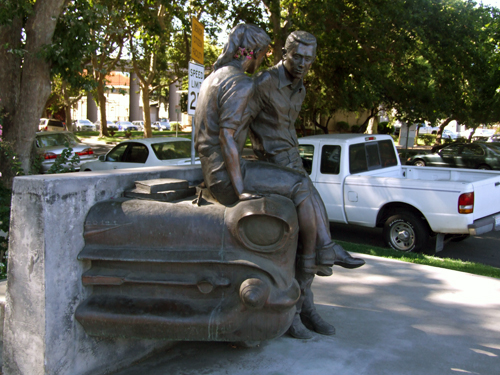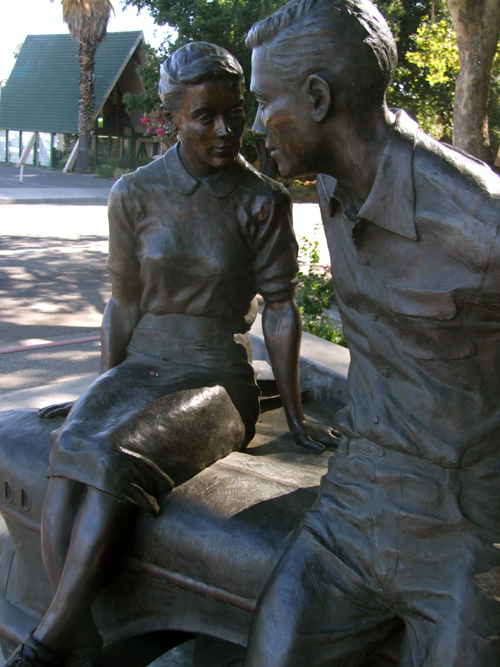
By Donald H. Harrison
MODESTO, California—A plaza located where five streets intersect boasts a life-size sculpture of a teenage girl seated on the side of a 1957 Chevrolet and a high school-aged boy leaning against it as they talk. It’s an ode to the movie American Graffiti by one of Modesto’s most famous former residents, filmmaker George Lucas.
According to a plaque accompanying the sculpture by Betty Saletta, Lucas was a member of Thomas Downey High School’s graduating class of 1962. The movie was about high school students and America’s car culture of the early 1960s – drive-in restaurants, cruising the boulevards, drag racing, and those songs on the radio about cars.
Downey High School was built in 1951 as Modesto’s second high school and was named for the educator who came to Modesto 60 years earlier and pushed successfully for creating the first high school that was housed separately from the grammar school. This year, Thomas Downey High School, George Lucas’s alma mater, is celebrating its 60th anniversary.
American Graffiti, with a non-stop soundtrack drawing on the rock n’ roll songs of the period, followed several teenagers on their last evening as high school students as they cruised in their automobiles through downtown Modesto (although it was actually filmed in Petaluma). It furthered the acting careers of Richard Dreyfuss, Harrison Ford, Cindy Williams, Mackenzie Phillips and Ron Howard, among others.
The film also was the basis for the long-running television series Happy Days, in which Ron Howard was the typical middle class high school student Richie Cunningham who hero-worshipped the “cool” blue collar Arthur “Fonzie” Fonzarelli, made famous by actor Henry Winkler.
Henry Winklerm Richard Dreyfuss, and Harrison Ford are Jewish.
After seeing the movie and the statue, grandson Shor, 10, asked why the word “Graffiti” was in its title. Nobody was spray painting walls in the movie, and there were no slogans on the statue either, he pointed out. I thought about his perceptive question some time before I was able to formulate an answer.
Even as graffiti is a form of temporary art or message – sometimes good, sometimes bad –the early-1960s culture depicted by the movie also was a temporary phenomenon. Those were the years when American teenagers could afford the luxury of being preoccupied by whose jalopy could go faster, or which automobile looked “cooler.” Just on the time horizon were far more serious events – the assassinations of President John F. Kennedy, Martin Luther King, Robert Kennedy and Malcolm X, the black-white race divisions in the country, the Civil Rights Movement, and the Vietnam War. Those were heavy, heavy times, and not the “happy days” of American Graffiti.
For Lucas, there was an added dimension to the transition from a near frivolous era to a deadly serious one. While making a left turn one night onto the dirt road leading to his house, he was broadsided by an oncoming car driven by another Downey High School student. Emergency measures were required to save his life. This, of course, was a sobering experience for him; he had been given a second chance at life. Maybe he should do more with his life than fixing up his car, revving his engine, and trying to be cool. It was a reckoning that led to him enrolling at film school at the University of Southern California.
*
Harrison is editor of San Diego Jewish World. He may be contacted at donald.harrison@sdjewishworld.com This concludes the series on West Coast sightseeing in the U.S. and Canada.
File: US Canada West 25
